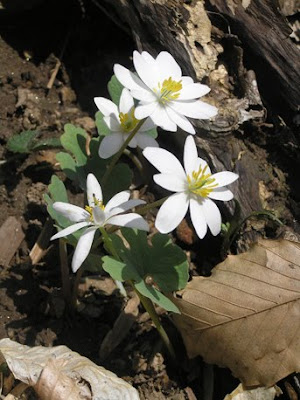The bloodroot flower is a species of herbaceous perennial that belongs to the sanguinaria genus. This genus contains only a single species and is a member of the papaveraceae family. These plants, which grow their best in rich soil and well-shaded areas, grow in abundance within Canada and eastern portions of the United States. The bloodroot flower’s name was derived from the thick red sap that seeps from the rhizome. The flower itself consists of eight to twelve white, oblong-shaped petals which surround distinctive golden yellow stamens at the center. The leaves of this flower – which are actually a single large leaf that develops at the base of the flower head – has a clasping, cape-like appearance which is used to protect the plant by closing around the head at night, and shading it when it begins to bear fruit.
Although the bloodroot flower is largely considered to be toxic, it has long been used to treat a number of ailments. Many North American tribes used this plant for a variety of reasons, from medicine to dye making. For generations, the bloodroot – which was also referred to as puccoon – has been used to create salves, poultices, pastes and powders. These concoctions are used to treat everything from oral infections, ward off the onset of gangrene, and to cure tumors, warts and polyps. In modern times, the bloodroot flower is widely thought to be a powerful anticancer agent. Although cancer patients have been treated with this plant for over 150 years, it is only recently that it has come under investigation for its long-known potential as a curative. In addition to its promising medicinal uses, the bloodroot flower is also attached to folklore and superstition. A Cherokee myth states that a tiny piece of the root should be carried at all times so as to ward off wicked spirits. On the other hand, an unmarried man of the Ponca tribe could rub the plant against his palm and hold the hand of his beloved; within the week, she would be his.
Since bloodroot flowers can cause an allergic reaction to the skin, it is not advisable to give them within a bouquet. However, as a gift, these blossoms look beautiful when presented in a decorative pot or dried and placed into a number of arrangements. As a symbol, bloodroots are thought to represent protective love, purification and healing, as well as strength and growth. As a gift, these blooms can be given to represent a wish for the recipient to get well after an illness, tell them you love them, or simply wish them the best for their life.






0 comments:
Post a Comment